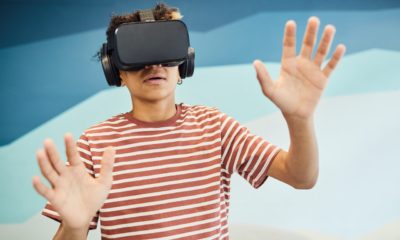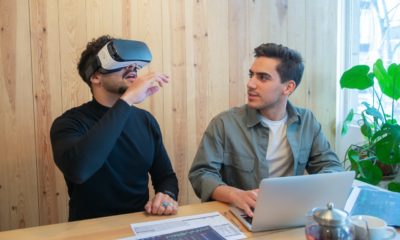Business
Virtual and Augmented Reality Are Shaking Up the Education Experience
While virtual and augmented reality are making a big impact in all manner of fields, education is one sector that stands to gain the most. With benefits including faster learning, better knowledge retention, and more engaged learners, the future looks bright for students of all ages. So what are some of these benefits, and how are companies like XRApplied delivering them to teachers and students?

Virtual and augmented reality are finding unprecedented levels of success in all manner of fields. Sports, remote work, design, tourism, gaming… if you can name it, then VR and AR are making a big impact as we speak. But, of all the fields where these new immersive technologies are making themselves felt, the one that is perhaps the most positively affected is that of education.
So how do virtual reality and augmented reality fit into education? How can teachers use it to enhance existing coursework and introduce students to new concepts and experiences? How do students react to the technology, and what impacts does it have on their learning and retention of information? And how do AR and VR fit into the overall digital learning landscape?
These are all questions that we’re about to answer.
Virtual and Augmented Reality Basics
Before answering the more specific questions above, it’s first necessary to get a solid understanding of what virtual and augmented reality are: digital, three-dimensional objects and environments generated by a computer.
When we refer to augmented reality, these digital objects are overlaid onto the real-world the user is currently immersed in. This is done using either smartphones or specially designed smartglasses. On the other hand, virtual reality allows the user to interact in an entirely simulated environment—like a computer game, but in immersive 3D.
Both of the technologies are capable of reproducing a wide array of physical experiences, and VR, in particular, has the potential to push learning beyond the traditional experiences. Indeed, it’s possible to quite literally take students to the moon. However, that’s not to say that ultra-immersive simulated environments are all that augmented reality and virtual reality can offer. Far from it.
The Role of Virtual and Augmented Reality in Learning
Historically, learning has been constantly revolutionized by technological tools. This includes everything from simply replacing trig tables (and a whole lot more) with pocket calculators, right through to today, where computers are now just about mandatory in any learning environment. Now, virtual and augmented reality are promising to deliver the next big revolution in education technology. And what a revolution it will be.
More than simple learning aids or substitutions, VR and AR are proving that they come with extremely promising benefits, such as speeding up learning and improving retention of rote-learned materials. They can also be used to encourage problem-solving and decision-making and enhance the learning experience in general, thanks to realistic exercises that traditional techniques cannot provide due to constraints like cost and safety.
On this note, the safe learning environment AR and VR provide is worth noting. It is only natural for mistakes to occur during learning, and the use of simulations allows learners to operate in a safe and controlled environment. This is important as a huge part of learning is conducting experiments and learning from failures—students cannot try different approaches and figure out for themselves what works best if there is a danger to them.
Bridging the Theory-Practice Gap
Extending this idea of experimentation and experience in learning, virtual and augmented reality create important bridges between theory and practice for students. For example, learners often rely on practical experience to assimilate theory from the textbook into real-world practice—what better way to achieve this than through interactive 3D environments that provide memorable experiences?
Further, this also extends to assessment. In the same way that they can be used to facilitate experiments and practical experience, VR and AR can facilitate the assessment of complex subjects in a contextual environment. By simulating a series of complex tasks, it becomes possible to assess the skills of the learner in applying their knowledge rather than simply testing their ability to regurgitate it in response to a question on a written exam.
Virtual and Augmented Reality Create More Engaged Learners
Besides broadening the range of practical environments teachers can expose students to, the other major benefit of virtual and augmented reality is the active engagement of learners. A perfect real-world example of this comes from XRApplied and its Balloon Pop Fun Learning—an app that teaches young learners essential skills like basic literacy and numeracy.
Traditionally, teaching young children basic numeracy and literacy skills has been a tedious task at best. At least if it’s done in a way that encourages a proper understanding of the material. This has resulted in generations of learners being raised on a well-known repertoire of sing-songs and rote-memorization techniques. And while these work in getting children to remember some information, they fail in getting children to apply it to new situations.
As an example, while many children can easily count to ten with their eyes closed, many resort to using their fingers and counting back up from one to count even small quantities of an object.
Solving this, XRApplied has worked out a way to get children deeply engaged in learning letters, numbers (and a whole lot of other things) through its Balloon Pop Fun Learning app. It achieves this by immersing young learners in an augmented reality archery game. But the twist is that the child must use their bow and arrow to pop specific balloons according to a prompt.
The effect of this is that the child doesn’t feel like they’re being “forced to count.” Instead, they’re playing a game they find highly enjoyable, and it just so happens that they’re counting as part of the game.
The Future of Education Is Just Beginning
It is undeniable that virtual and augmented reality are innovative technologies that are already having profound effects in the context of education. These positive benefits will only increase over time, too. Once teachers and students get more experience with the different applications and discover what works and doesn’t work, existing applications will improve and, more likely than not, new applications will be created.
This is paving the way for an education landscape full of exciting developments—one where students, teachers, and companies like XRApplied work hand in hand to create the best educational experience possible.
—
(Featured by Julia M Cameron via Pexels)
DISCLAIMER: This article was written by a third-party contributor and does not reflect the opinion of Born2Invest, its management, staff, or its associates. Please review our disclaimer for more information.
This article may include forward-looking statements. These forward-looking statements generally are identified by the words “believe,” “project,” “estimate,” “become,” “plan,” “will,” and similar expressions. These forward-looking statements involve known and unknown risks as well as uncertainties, including those discussed in the following cautionary statements and elsewhere in this article and on this site. Although the Company may believe that its expectations are based on reasonable assumptions, the actual results that the Company may achieve may differ materially from any forward-looking statements, which reflect the opinions of the management of the Company only as of the date hereof. Additionally, please make sure to read these important disclosures.

-

 Impact Investing2 weeks ago
Impact Investing2 weeks agoEU Eases CO2 Tax Burden on SMEs with Revised CBAM Rules
-

 Fintech10 hours ago
Fintech10 hours agoRobinhood Expands to Europe with Tokenized Stocks and Perpetual Futures
-

 Business1 week ago
Business1 week agoAmerica’s Debt Spiral: A $67 Trillion Reckoning Looms by 2035
-

 Crowdfunding5 days ago
Crowdfunding5 days agoTasty Life Raises €700,000 to Expand Pedol Brand and Launch Food-Tech Innovation
























